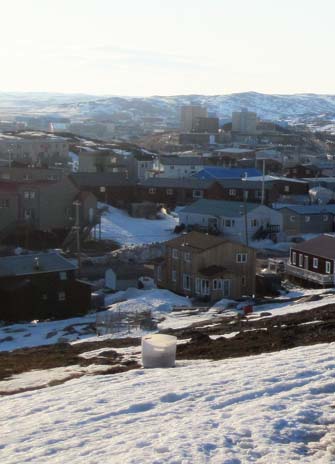
Researchers from York University’s Faculty of Education are participating in a project to deliver immersive and interactive education services to remote and northern Aboriginal and Inuit communities through high-definition two-way video communication and collaboration technology. Last week, the Government of Nunavut and Cisco Canada officially launched Connected North, a project designed to showcase innovations in technology-enhanced learning with the aim of engaging students more deeply in the study of science. The virtual education program utilizes Cisco TelePresence and Partners in Research’s Virtual Researcher on Call (VROC) program for schools.

Connected North Launch Event April 2. From left: Kevin Cougler, executive director of Partners in Research; Professor Celia Haig-Brown; Professor Ron Owston; Alesha Moffat; and Nitin Kawale, president of Cisco Canada
York researchers are evaluating the program at Aqsarniit Middle School in Iqaluit, Nunavut, through a variety of methods including visiting the school to observe Connected North sessions in Grade 6, 7 and 8 classrooms, surveying students, interviewing teachers and talking to community members. York University Faculty of Education Dean Ron Owston is leading the project together with Associate Dean of Research and Professional Development Celia Haig-Brown. Working with Owston and Haig-Brown are Faculty of Education doctoral student Alesha Moffat and senior research associate Herb Wideman.
“During the pilot phase of the program, which was initiated in 2013, we began a baseline study to look at the initial impact of the program on students,” said Owston. “Our research looked at how engaged students were when they connected with VROC scientists via the TelePresence videoconferencing technology and how teachers were able to integrate the VROC programming into their curriculum.”
Moffat, a former teacher in Nunavut who intends to return to the North to conduct doctoral dissertation fieldwork, travelled to Iqaluit as part of the evaluation. “I appreciated the opportunity to work with staff and students at Aqsarniit Middle School,” said Moffat. “The experience of interviewing teachers, observing Connected North sessions, administering questionnaires to participating classes and co-authoring the interim report has been invaluable in relation to my own work.”
Preliminary results show that both teachers and students view the program positively. A majority (89 per cent) of students reported that the remote learning experience made science more enjoyable and 80 per cent said they felt they learned more in the virtual sessions than they did through traditional classroom learning. “This May we’ll be going back to look at changes in students’ and teachers’ perceptions of the program.”
